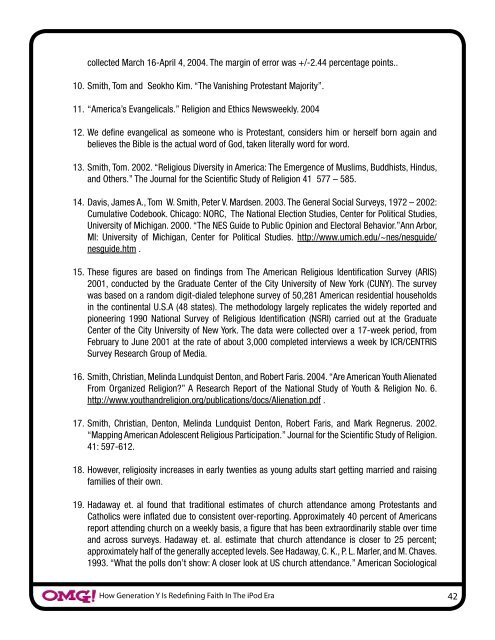OMG! How Generation Y Is Redefining Faith in the iPod Era. - Circle
OMG! How Generation Y Is Redefining Faith in the iPod Era. - Circle
OMG! How Generation Y Is Redefining Faith in the iPod Era. - Circle
You also want an ePaper? Increase the reach of your titles
YUMPU automatically turns print PDFs into web optimized ePapers that Google loves.
collected March 16-April 4, 2004. The marg<strong>in</strong> of error was +/-2.44 percentage po<strong>in</strong>ts..<br />
10. Smith, Tom and Seokho Kim. “The Vanish<strong>in</strong>g Protestant Majority”.<br />
11. “America’s Evangelicals.” Religion and Ethics Newsweekly. 2004<br />
12. We def<strong>in</strong>e evangelical as someone who is Protestant, considers him or herself born aga<strong>in</strong> and<br />
believes <strong>the</strong> Bible is <strong>the</strong> actual word of God, taken literally word for word.<br />
13. Smith, Tom. 2002. “Religious Diversity <strong>in</strong> America: The Emergence of Muslims, Buddhists, H<strong>in</strong>dus,<br />
and O<strong>the</strong>rs.” The Journal for <strong>the</strong> Scientific Study of Religion 41 577 – 585.<br />
14. Davis, James A., Tom W. Smith, Peter V. Mardsen. 2003. The General Social Surveys, 1972 – 2002:<br />
Cumulative Codebook. Chicago: NORC, The National Election Studies, Center for Political Studies,<br />
University of Michigan. 2000. “The NES Guide to Public Op<strong>in</strong>ion and Electoral Behavior.”Ann Arbor,<br />
MI: University of Michigan, Center for Political Studies. http://www.umich.edu/~nes/nesguide/<br />
nesguide.htm .<br />
15. These figures are based on f<strong>in</strong>d<strong>in</strong>gs from The American Religious Identification Survey (ARIS)<br />
2001, conducted by <strong>the</strong> Graduate Center of <strong>the</strong> City University of New York (CUNY). The survey<br />
was based on a random digit-dialed telephone survey of 50,281 American residential households<br />
<strong>in</strong> <strong>the</strong> cont<strong>in</strong>ental U.S.A (48 states). The methodology largely replicates <strong>the</strong> widely reported and<br />
pioneer<strong>in</strong>g 1990 National Survey of Religious Identification (NSRI) carried out at <strong>the</strong> Graduate<br />
Center of <strong>the</strong> City University of New York. The data were collected over a 17-week period, from<br />
February to June 2001 at <strong>the</strong> rate of about 3,000 completed <strong>in</strong>terviews a week by ICR/CENTRIS<br />
Survey Research Group of Media.<br />
16. Smith, Christian, Mel<strong>in</strong>da Lundquist Denton, and Robert Faris. 2004. “Are American Youth Alienated<br />
From Organized Religion?” A Research Report of <strong>the</strong> National Study of Youth & Religion No. 6.<br />
http://www.youthandreligion.org/publications/docs/Alienation.pdf .<br />
17. Smith, Christian, Denton, Mel<strong>in</strong>da Lundquist Denton, Robert Faris, and Mark Regnerus. 2002.<br />
“Mapp<strong>in</strong>g American Adolescent Religious Participation.” Journal for <strong>the</strong> Scientific Study of Religion.<br />
41: 597-612.<br />
18. <strong>How</strong>ever, religiosity <strong>in</strong>creases <strong>in</strong> early twenties as young adults start gett<strong>in</strong>g married and rais<strong>in</strong>g<br />
families of <strong>the</strong>ir own.<br />
19. Hadaway et. al found that traditional estimates of church attendance among Protestants and<br />
Catholics were <strong>in</strong>flated due to consistent over-report<strong>in</strong>g. Approximately 40 percent of Americans<br />
report attend<strong>in</strong>g church on a weekly basis, a figure that has been extraord<strong>in</strong>arily stable over time<br />
and across surveys. Hadaway et. al. estimate that church attendance is closer to 25 percent;<br />
approximately half of <strong>the</strong> generally accepted levels. See Hadaway, C. K., P. L. Marler, and M. Chaves.<br />
1993. “What <strong>the</strong> polls don’t show: A closer look at US church attendance.” American Sociological<br />
<strong>How</strong> <strong>Generation</strong> Y <strong>Is</strong> <strong>Redef<strong>in</strong><strong>in</strong>g</strong> <strong>Faith</strong> In The <strong>iPod</strong> <strong>Era</strong> 42




